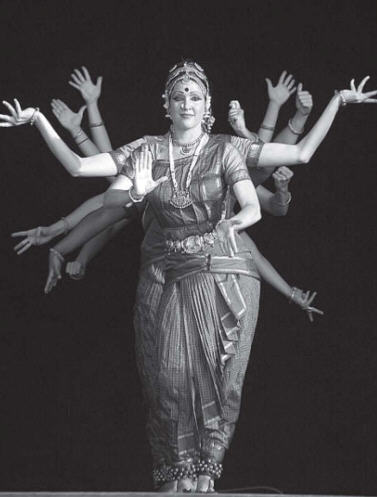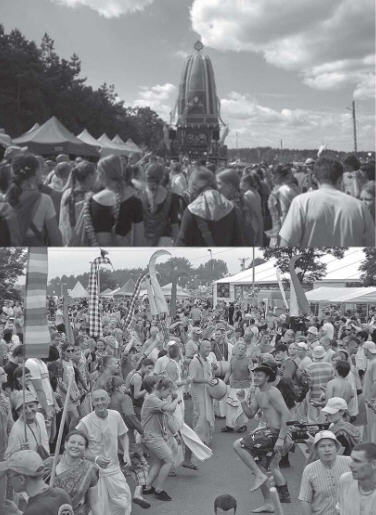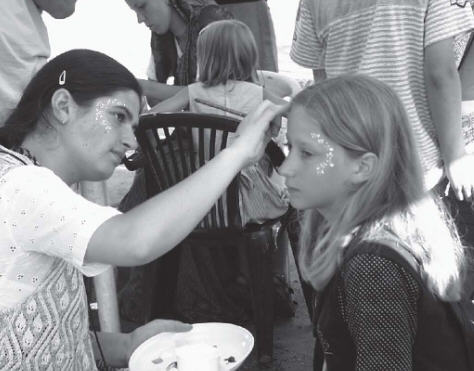A leading ISKCON guru discusses the adventures and excitements of
sharing Krishna consciousness with people around the world.
His Holiness Indradyumna Swami Maharaja is one of the foremost spiritual leaders of the International Society for Krishna consciousness, who has in addition to his global outreach also pioneered a “Festival of India” traveling program in Poland. That an American Swami is spearheading a festival of Indian bhakti culture in Europe reflects both the intrinsic, universal appeal of bhakti and its remarkable global spread in recent times. We are privileged to present an interview with Indradyumna Swami (IS):
BTG: How were you introduced to Krishna consciousness?
IS: I was born as Brian Tibbitts on May 20, 1949, in Palo Alto, California, after surviving a struggle with spinal meningitis at age four and the death of a neighborhood dog at age six. I began contemplating existential questions concerning the nature of life and death, happiness and distress, real love and the purpose of the universe. Unable to find the answers within my home community, I left home to find the secret of a “truly satisfying life” at age sixteen. An idealist, I eventually joined the US Marines to stop the spread of communism in Vietnam. A year later I was honorably discharged as a conscientious objector.
Shortly thereafter in 1970 I met members of ISKCON in Detroit, Michigan and became a member, moving into the temple at 8311 East Jefferson. Within a week of joining I was leading congregational chanting kirtana and distributing spiritual literature such as Bhagavad-gita and Srimad-Bhagavatam. In December 1971 I was awarded initiation by my spiritual master A.C. Bhaktivedanta Swami Prabhupada and received the name Indradyumna after a saintly king described in India’s ancient traditions.

BTG: How did you choose Poland as your preaching focus? In your Polish outreach, you showcase Indian culture through an integrated “Festival of India” program as a means for introducing people to Krishna consciousness. How did this innovative outreach program start and expand? What are its salient features? How has been the response?
IS: Poland became my focus by guru and Krishna’s arrangement rather than my own. Following Srila Prabhupada’s order to me to “preach boldly and have faith in the holy name” I left the USA in 1972 journeying to Europe, where I helped open new centers in France, Italy, Switzerland, and Belgium. In 1979 at age 29 I took a vow of lifelong dedication to missionary activities as a celibate monk and entered the renounced order of sannyasa as Indradyumna Swami Maharaja. In the same year I founded a traveling festival group that toured all over France sharing India’s spiritual teachings and cultural traditions of music, dance, and food.
The Polish “Festival of India” tour began quite spontaneously when I visited Poland in the summer of 1990. I was beginning a tour of the former communist East Block countries as well as Russia, which was still communist at the time. The Polish devotees organized a few successful public programs that not only greatly inspired the devotees and guests, but inspired me as well. The Polish devotees offered to organize more festivals, if I agreed to stay in Poland longer. So I cancelled my further travel plans to Czechoslovakia, Hungary and Yugoslavia. For a month a group of ten or twelve of us traveled the length and breadth of the country, performing harinama-sankirtana and holding public engagements.
By the summer of 1996 all the festivals were outdoor events. Rented truck trailers were decorated as stages; programs included Indian dance, a renewed Ramayana mask theatre and a Reggae concert, as well as our standard lecture and kirtana. A village of tents housing exhibits on reincarnation, vegetarianism, Vedic science and Krishna art were added to the festival set up. Bigger shops selling a greater selection of Indian handicrafts were added along with a vegetarian restaurant with a great variety of tasty preparations. As the “Festival of India” became more professional, its fame increased and more people, between 2000 and 10,000, would attend each event. By 1997 not only were the festivals bigger but we had also learnt how to do more festivals. We invested in a semi trailer Mercedes truck with a professional looking folding stage.
Today, more than 20 years later, the festivals are still going strong, seeking to introduce people to India’s ancient cultural traditions through a feast of entertainment and education involving: classical Indian dance performances theaters with larger than life puppets presentations on classical Indian texts such as Bhagavad-gita, musical performances, graphic exhibits stalls with books, handicrafts and vegetarian cuisine. The events are attended by between 5,000 to 10,000 people at a time. Over 200 volunteers from around the world participate in setting up equipment, running the stalls, performing on stage, and advertising the festivals. An estimated 750,000 people attend the events each summer.
I have also taken the Festival of India to Australia, Brazil, and the USA touring as Le Carnival Spirituel. The indoor events center on a dynamic two-hour stage program of spiritual cultural entertainment including yoga acrobats, pantomimes, as well as a talk on Bhagavad-gita and kirtana.

BTG: The biggest event in the Polish outreach is the Woodstock festival. How did your participation there start? What have been the highlights of that participation?
IS: Since 1996 our Polish Festival of India team has participated in the Przystanek Woodstock free music festival organized over the first weekend in August each year by Jurek Owsak of the Great Orchestra of Christmas Charity. Dubbed Europe‘s largest annual open-air event, Przystanek Woodstock is attended by over 300,000 people each year. Within the mayhem of this setting our Festival of India team of more than 500 volunteers set up a spiritual sanctuary called “Krishna‘s Village of Peace”. In the village, festival goers can participate in spiritual discussions and cultural performances, or join the line at the Food for Peace tent to receive one of 90,000 plates of vegetarian food distributed there each year. The highlight of this participation has been seeing hundreds of thousands of people engage in activities of Krishna consciousness at a single time. For example when our devotees go on the main stage, 300,000 people sing Krishna’s holy names and dance together. And from our “Village” over a three-day period, we distribute 150,000 plates of hot prasada to very appreciative festival participants.
BTG: Your Diary of a Traveling Monk series describes movingly your adventures during outreach in various parts of the world. What, for you, has been the most inspiring outreach experience or realization?
IS: My deepest realization as a traveling monk is that everywhere, all over the world people are trying to be happy, yet, mostly people experience suffering. This is because they are seeking happiness in the wrong place. People are in illusion regarding their identity, thinking themselves to be their bodies, rather than realizing they are spirit soul. The nature of the soul is eternity, knowledge and bliss. But because people are unaware of their spiritual nature, they seek happiness in their bodies and other bodies of flesh and blood, rather than in their eternal spiritual relationship with Krishna and other souls. Therefore people increasingly feel disconnected, empty and hollow with “mental illnesses” such as stress, anxiety, and depression. This is the great tragedy of modern, so-called civilization. Although we are so advanced in science and technology, we are primitive in experiencing spirituality, loving relationships, and genuine happiness.
BTG: How did you originally conceive the idea of writing the diary? How has been its response from within and outside the devotee community?
IS: I see rampant materialism and suffering all over the world and it fills my heart with compassion. I travel and share my experiences as a traveling monk to show people the alternative to a meaningless materialistic existence in the teachings of the Bhagavad-gita and the Krishna conscious lifestyle. Everyday as I do this, I encounter miracles as people suddenly become awakened to their spiritual nature. These are profound transformational moments that even increase my own faith in the power of Krishna consciousness. I become spiritually awakened and inspired in these experiences and so I write to share them with others the readers of the Diary of a Traveling Monk. My readers often report that they also become spiritually inspired and feel more committed on reading these accounts, which encourages and inspires me in my service.
BTG: On reading your diary, some devotees feel that, in contrast to the adventurousness of your life, their lives are quite monotonous. What are the things that devotees can do to make their Krishna conscious lives more lively?
IS: Becoming Krishna conscious is the ultimate adventure. The path is fraught with challenges and obstacles, but the reward is the greatest of all treasures freedom from birth and death and more importantly, entry into Krishna’s own abode to serve in His eternal pastimes. As in any adventure, if we become careless and casual, we will become a casualty to the material nature and think of our lives as boring and monotonous. If we are within the fire of Krishna consciousness, we will experience everyday as a festival. This awareness becomes particularly tangible when we focus on sharing Krishna consciousness with others. Then we are no longer focused on ourselves but on Krishna and other people, and Krishna gives us special empowerment to represent Him. This will enliven us and deepen our own faith. There is no adventure like sharing Krishna with other people who have forgotten Him.

BTG: The same Indian culture that is being accepted increasingly in the West is being increasingly shelved in India due to rapid westernization. What is your insight on this paradox?
IS: India’s lack of appreciation for her own spiritual wisdom and culture is the greatest tragedy and a symptom of the advance of the age of Kali and is one of the frequent themes of my Diary of a Traveling Preacher. India’s leaving her own cultural treasures in favor of western alternatives is like a fool who gives up a gold pot for a lump of iron. I am not against Western science and technology, but it should not be embraced at the expense of India’s right spiritual heritage. Rather it should be adopted as an addition to India’s profound spiritual wisdom. If you have technology without the wisdom of how to use it, then it will lead to destruction.
Western civilization has not only given birth to technology, but also to the greatest destruction the world has ever seen. This includes the destruction of the environment, the erosion of social values, the demise of ancient cultures, and the death of love, happiness, and compassion, with a rise of selfish individualism. Therefore, technology is not enough for a peaceful and harmonious society. We need spiritual values and wisdom that will guide us in using technology in a manner that is beneficial rather than destructive.
I am particularly concerned seeing India’s neglect of Vrindavana the holy land of Krishna’s pastimes in North India. There is mining in for stone in Vrindavana’s sacred hills, the Yamuna River is terribly polluted, and sacred places are being overrun by commercial development projects. These treasures of India’s great heritage should not be destroyed. They belong to the world, not just to India. Vrindavana’s sacred places, temples, stories, and the sadhus who live there, must all be preserved for the benefit of future generations.
The interview was conducted by Caitanya Carana Dasa on behalf of BTG.
Indradyumna Swami’s travelling monk’s diaries have recently been re-published as economy editions and are available at most ISKCON books stores. They can also be obtained by contacting Vishnuloka Dasa at vishnulok.rns@gmail.com or +91 9242176587.
To know more about Indradyumna Swami, visit www.indradyumnaswami.com
